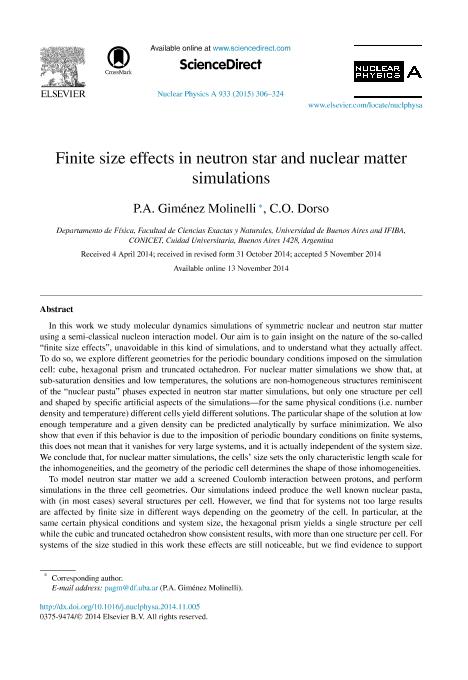Mostrar el registro sencillo del ítem
dc.contributor.author
Giménez Molinelli, Pedro Agustín

dc.contributor.author
Dorso, Claudio Oscar

dc.date.available
2017-06-15T17:48:23Z
dc.date.issued
2015-01
dc.identifier.citation
Giménez Molinelli, Pedro Agustín; Dorso, Claudio Oscar; Finite size effects in neutron star and nuclear matter simulations; Elsevier Science; Nuclear Physics A; 933; 1-2015; 306-324
dc.identifier.issn
0375-9474
dc.identifier.uri
http://hdl.handle.net/11336/18255
dc.description.abstract
In this work we study molecular dynamics simulations of symmetric nuclear and neutron star matter using a semi-classical nucleon interaction model. Our aim is to gain insight on the nature of the so-called “finite size effects”, unavoidable in this kind of simulations, and to understand what they actually affect. To do so, we explore different geometries for the periodic boundary conditions imposed on the simulation cell: cube, hexagonal prism and truncated octahedron. For nuclear matter simulations we show that, at sub-saturation densities and low temperatures, the solutions are non-homogeneous structures reminiscent of the “nuclear pasta” phases expected in neutron star matter simulations, but only one structure per cell and shaped by specific artificial aspects of the simulations—for the same physical conditions (i.e. number density and temperature) different cells yield different solutions. The particular shape of the solution at low enough temperature and a given density can be predicted analytically by surface minimization. We also show that even if this behavior is due to the imposition of periodic boundary conditions on finite systems, this does not mean that it vanishes for very large systems, and it is actually independent of the system size. We conclude that, for nuclear matter simulations, the cells' size sets the only characteristic length scale for the inhomogeneities, and the geometry of the periodic cell determines the shape of those inhomogeneities. To model neutron star matter we add a screened Coulomb interaction between protons, and perform simulations in the three cell geometries. Our simulations indeed produce the well known nuclear pasta, with (in most cases) several structures per cell. However, we find that for systems not too large results are affected by finite size in different ways depending on the geometry of the cell. In particular, at the same certain physical conditions and system size, the hexagonal prism yields a single structure per cell while the cubic and truncated octahedron show consistent results, with more than one structure per cell. For systems of the size studied in this work these effects are still noticeable, but we find evidence to support that the dependence of the results on the cell geometry becomes smaller as the system size is increased. When the Coulomb interaction is present, the competition between opposing interactions of different range results in a proper, physically meaningful length scale that is independent of the system size and periodic cell of choice. Only under these conditions “finite size effects” will vanish for large enough systems (i.e. cells much larger than this characteristic length). Larger simulations are in order, but our computational capabilities forbid it for the time being.
dc.format
application/pdf
dc.language.iso
eng
dc.publisher
Elsevier Science

dc.rights
info:eu-repo/semantics/openAccess
dc.rights.uri
https://creativecommons.org/licenses/by-nc-sa/2.5/ar/
dc.subject
Nuclear Matter
dc.subject
Neutron Star Matter
dc.subject
Nuclear Pasta
dc.subject
Simulations
dc.subject.classification
Física Nuclear

dc.subject.classification
Ciencias Físicas

dc.subject.classification
CIENCIAS NATURALES Y EXACTAS

dc.title
Finite size effects in neutron star and nuclear matter simulations
dc.type
info:eu-repo/semantics/article
dc.type
info:ar-repo/semantics/artículo
dc.type
info:eu-repo/semantics/publishedVersion
dc.date.updated
2017-06-12T18:05:04Z
dc.journal.volume
933
dc.journal.pagination
306-324
dc.journal.pais
Países Bajos

dc.journal.ciudad
Amsterdam
dc.description.fil
Fil: Giménez Molinelli, Pedro Agustín. Consejo Nacional de Investigaciones Científicas y Técnicas. Oficina de Coordinación Administrativa Ciudad Universitaria. Instituto de Física de Buenos Aires. Universidad de Buenos Aires. Facultad de Ciencias Exactas y Naturales. Instituto de Física de Buenos Aires; Argentina
dc.description.fil
Fil: Dorso, Claudio Oscar. Consejo Nacional de Investigaciones Científicas y Técnicas. Oficina de Coordinación Administrativa Ciudad Universitaria. Instituto de Física de Buenos Aires. Universidad de Buenos Aires. Facultad de Ciencias Exactas y Naturales. Instituto de Física de Buenos Aires; Argentina
dc.journal.title
Nuclear Physics A

dc.relation.alternativeid
info:eu-repo/semantics/altIdentifier/doi/http://dx.doi.org/10.1016/j.nuclphysa.2014.11.005
dc.relation.alternativeid
info:eu-repo/semantics/altIdentifier/url/http://www.sciencedirect.com/science/article/pii/S0375947414005508
dc.relation.alternativeid
info:eu-repo/semantics/altIdentifier/url/https://arxiv.org/abs/1403.5777
Archivos asociados
